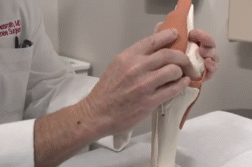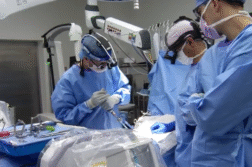LOS ANGELES, Calif. (Ivanhoe Newswire) – More than 53,000 people will have shoulder replacement surgery this year. The average age is 60 to 80. And just like knee and hip replacement surgeries, this procedure can be a life changer. Now, technology used in some of the latest mixed reality games is making this surgery even better than ever before.
Pokemon Go — a mixed reality game that captivated millions of people — urging them to find this 3D hologram character super imposed in their own reality — is now becoming a reality in the O.R.
“The mixed reality headset allows us to use the patient’s anatomy in a 3D constructed program that allows us to plan for their case,” orthopedic surgeon at Scripps Clinic in La Jolla, California, Brian Rebolledo, MD, explains.
Dr. Rebolledo is one of the first in the country to use 3D hologram technology to give him more insight at the operating table during surgery.
“It gives us a detailed map of the patient’s anatomy and we bring that map into the operating room with us. So, we’re able to use the headset with the 3D hologram and bring that right next to the patient while we’re putting the implants in,” Dr. Rebolledo further explains.
Before surgery, CT scans are used to create a hologram of the patient’s shoulder.
Dr. Rebolledo adds, “The technology works with a headset that we use in the operating room, and this is by voice command and hand control commands.”
Surgeons can rotate and zoom in or out of the hologram model while comparing it in real time to the patient’s own anatomy.
“What that allows us to do is to minimize the risk of improper placement, to minimize the risk, hopefully, of loosening over time, and to minimize risk to the soft tissue around the shoulder,” Dr. Rebolledo mentions.
Before 3D holograms, surgeons relied on X-rays and CT scans to help guide them. This gives them an even more realistic view of what’s really going on. Scripps Clinic is one of 33 health care providers in the U.S. using mixed reality technology for shoulder replacement surgery.
Contributors to this news report include: Marsha Lewis, Producer; Roque Correa, Videographer & Editor.
To receive a free weekly e-mail on medical breakthroughs from Ivanhoe, sign up at: http://www.ivanhoe.com/ftk
Source:
https://orthoinfo.aaos.org/en/treatment/shoulder-joint-replacement/
MEDICAL BREAKTHROUGHS
RESEARCH SUMMARY
TOPIC: FROM GAMING TO THE O.R.: MIXED REALITY FOR SHOULDER REPLACEMENT SURGERY
REPORT: MB #5134
BACKGROUND: Shoulder replacement removes damaged areas of bone and replaces them with parts made of metal and plastic, which are called implants. This surgery is called shoulder arthroplasty. The shoulder is a ball-and-socket joint. The round head, or ball, of the upper arm bone fits into a shallow socket in the shoulder. Damage to the joint can cause pain, weakness and stiffness. About 53,000 people in the U.S. have shoulder replacement surgery each year, according to the Agency for Healthcare Research and Quality. This compares to more than 900,000 Americans a year who have knee and hip replacement surgery.
(Sources: https://www.mayoclinic.org/tests-procedures/shoulder-replacement/about/pac-20519121
DIAGNOSING: Shoulder replacment symptoms include, but are not limited to, loss of motion or weakness in the shoulder, severe shoulder pain that interferes with every day life, and/or moderate to severe pain at rest, or difficulty sleeping. Doctors can make a diagnosis by performing x-rays or CT scans.
NEW TECHNOLOGY: At Summit, shoulder surgeons including Dr. Freehill are using computer 3D modeling technology to convert a patient’s preoperative imaging studies to a 3D computer model. Using that model, Dr. Freehill said, “We can conduct a virtual simulation of the surgery, test different implants to see how they fit, and determine how the implant would be best positioned within the shoulder itself. Using this technology, we can predict the implant type, how it will be seated, and even generate a special guide to align the implant optimally during shoulder replacement surgery.”
(Source:
https://www.summitortho.com/2022/03/22/new-options-for-shoulder-replacement/)
FOR MORE INFORMATION ON THIS REPORT, PLEASE CONTACT:
Stephen Carpowich
(858) 312-0328
Carpowich.stephen@scrippshealth.org
If this story or any other Ivanhoe story has impacted your life or prompted you or someone you know to seek or change treatments, please let us know by contacting Marjorie Bekaert Thomas at mthomas@ivanhoe.com




